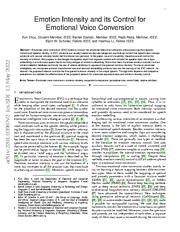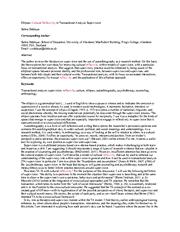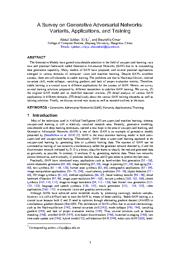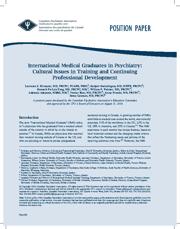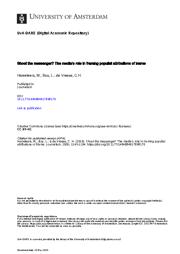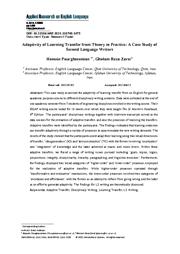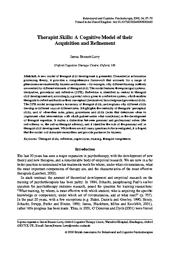A copy of this work was available on the public web and has been preserved in the Wayback Machine. The capture dates from 2022; you can also visit the original URL.
The file type is application/pdf.
Filters
Emotion Intensity and its Control for Emotional Voice Conversion
[article]
2022
arXiv
pre-print
We propose to disentangle the speaker style from linguistic content and encode the speaker style into a style embedding in a continuous space that forms the prototype of emotion embedding. ...
As desired, the proposed network controls the fine-grained emotion intensity in the output speech. ...
In [86] , an emotion recognizer is used to extract the style embedding for style transfer. ...
arXiv:2201.03967v2
fatcat:22h7iuofrnd33cf23xzrjun37m
Ellipses
2017
Transactional Analysis Journal
The author reviews the literature on supervision and the use of autoethnography as a research method. ...
She suggests that supervisory practice could be enhanced by being aware of the elliptical spaces between personal identity and the professional role, between supervisor and supervisee, and between both ...
alliance, supervisor style, and supervisor (non)disclosure-were inextricably linked with and influenced the outcomes for both the therapy and the supervision process. ...
doi:10.1177/0362153717695071
fatcat:aoaoe4yf25g4ffs3dhj5zbiuaa
Gender issues in the university research environment
2010
European Journal of Engineering Education
Focus groups are used to examine the attitudes and experiences of females, and a questionnaire used to explore perceptions in four main skills areas: group work; communication; personal awareness; and ...
Levels of response could be gauged through the colour coding of transcribed text, such as blue text for topics pertaining to discrimination.
Results and Discussion. SKIPI Data. ...
Accordingly, this study initially investigates female self-perceptions about some key transferable skills related to effective research work and career management. ...
doi:10.1080/03043790903497302
fatcat:vztacsfclnb6fm5rebhndbcxve
A Survey on Generative Adversarial Networks: Variants, Applications, and Training
[article]
2020
arXiv
pre-print
Finally, we discuss several new issues as well as research outlines to the topic. ...
well as training solutions. ...
Beauty GAN (B-GAN) [94] transfers the makeup style from makeup face to non-makeup face. ...
arXiv:2006.05132v1
fatcat:gyjezuh5sfdilkp43ydsea5cwa
Finding a Voice: Writing Narrative in the Early Stages of a Doctoral Thesis
2012
Journal of Academic Writing
Using extracts from one early-career research student's writing, supervisor notes and email messages, it argues that actual writers may continue to need and demand engagement in a variety of pedagogic ...
However, rather than analysing the texts of a number of different student writers, it examines different texts produced by the same writer. ...
Permission was given by K for her academic work to be used for research purposes. ...
doi:10.18552/joaw.v2i1.71
fatcat:sxmyoi2tg5ejrp5ue5cthdm36m
Effectively Employing Young Adult Peer Providers: A Toolkit
2017
Psychiatry Information in Brief
Provider and program leadership must support peers, co-workers and supervisors to work collaboratively through enhanced trainings, team building strategies, personnel policies, and sharing their enthusiasm ...
parallel processes for YA peers to experience as they guide and support their YA clients. ...
YA peers supervisors being confused about their role as a YA peer supervisor as well as the YA peers role at the agency. ...
doi:10.7191/pib.1175
fatcat:vxczrjqzsvdmnax5w7ld424bom
International Medical Graduates in Psychiatry: Cultural Issues in Training and Continuing Professional Development
2018
Canadian journal of psychiatry
Communication: Use verbal and non-verbal communication skills with patients, families, and professional colleagues. ...
Learning styles and strategies: Reflect on personal and cultural learning styles and strategies. ...
doi:10.1177/0706743717752913
pmid:29630854
pmcid:PMC5894917
fatcat:jyppze7p5rfs3oqtyl5rofz6xy
Shoot the messenger? The media's role in framing populist attributions of blame
2017
Journalism - Theory, Practice & Criticism
Using Latent Class Analysis, we first identified three distinct styles of reporting: neutral, conflict, and interpretative coverage. ...
In line with our predictions, we find that populist blame attributions are present most in conjunction with an interpretative journalistic style and least when a neutral journalistic style is used. ...
Populist blame attribution in election and non-election times As pointed out by Rooduijn (2014) , the media's attention to populism has almost exclusively been studied during election campaigns, neglecting ...
doi:10.1177/1464884917698170
fatcat:jkj5afg6t5aazklry45cznbmdu
Adaptivity of Learning Transfer from Theory to Practice: A Case Study of Second Language Writers
2021
Applied Research on English Language
The participants' disciplinary writings together with interview transcripts served as the data sources for the extraction of adaptive transfers and also the processes of realizing the transfers. ...
The results showed that the participants could adapt their learning along two broad dimensions of transfer, 'idea generation' (IG) and 'text construction' (TC) with the former involving 'explication' and ...
This use of knowledge gives rise to a linguistic universe parallel to the conceptual world, which coordinately realizes what we come to know as the text. ...
doi:10.22108/are.2021.126760.1675
doaj:851d35a38fb64e1e81fda39717644c66
fatcat:elwct5p2znfvdfzptalmfqihwy
Therapist Skills: A Cognitive Model of their Acquisition and Refinement
2005
Behavioural and Cognitive Psychotherapy
It makes a distinction between personal and professional selves (the self-schema vs. the self-as-therapist schema); and it identifies the role of the personal self in therapist skill development. ...
Reflection is identified as central to therapist skill development and, accordingly, a pivotal role is given to a reflective system, which enables therapists to reflect and build on their conceptual (declarative ...
As the therapist acquires therapy-specific skills, there is a progressive transfer of processing to the self-as-therapist schema. ...
doi:10.1017/s1352465805002420
fatcat:cjwbyqmshnd75mjxizziwus5iu
Management humor
2011
Organizational Psychology Review
The full-text may be used and/or reproduced, and given to third parties in any format or medium, without prior permission or charge, for personal research or study, educational, or not-for-profit purposes ...
provided that: • a full bibliographic reference is made to the original source • a link is made to the metadata record in DRO • the full-text is not changed in any way The full-text must not be sold in ...
Specifically, individuals with higher levels of discriminative competence will be better able to encode a message as humorous or non-humorous as compared to their lower level counterparts. ...
doi:10.1177/2041386611418393
fatcat:7sz5nutf2fdb7ksluwzw5qaf6y
Multimodal Deep Learning
[article]
2023
arXiv
pre-print
Finally, we also cover other modalities as well as general-purpose multi-modal models, which are able to handle different tasks on different modalities within one unified architecture. ...
Further, modeling frameworks are discussed where one modality is transformed into the other, as well as models in which one modality is utilized to enhance representation learning for the other. ...
The other important role is the supervisor. Thanks to all the supervisors who participated! ...
arXiv:2301.04856v1
fatcat:tsqlijavxvalrnaqzn3m3pz73a
Discourse 2.0: Language and new mediaTannenDeborahTresterAnna Marie (eds), Discourse 2.0: Language and new media, Georgetown University Press: Washington, DC, 2013; 258 pp.: ISBN 9781589019546, $44.95 (pbk)
2014
New Media & Society
ACKNOWLEDGMENTS We thank the student interns and supervisors who generously allowed us to collect and analyze their email messages. We also thank students in Cynthia Gordon ...
ACKNOWLEDGEMENTS I am grateful to all the students in my classes who helped me understand their own and their peers' uses of digital media in their personal interactions, especially those whose examples ...
The first supervisor (Supervisor A) self-identifies as an African American, female, PhD student with two years of experience. ...
doi:10.1177/1461444814524163b
fatcat:lix7m4khk5ep3f7d3ftd3psx3q
Humor in Workplace Leadership: A Systematic Search Scoping Review
2021
Frontiers in Psychology
Using qualitative review methods, four key themes in the research emerged relating to: (1) humor styles and outcomes; (2) humor as communication and discursive resource; (3) variables in the humor and ...
As a result, research methodologies and findings are not easily clarified, and have not been synthesized. ...
‘Parallel leadership in an “unparallel” world’—cultural constraints on the transferability of Western educational leadership theories across cultures. Int. J. Leadersh. ...
doi:10.3389/fpsyg.2021.610795
fatcat:d6kjqor4ufcf5j3wgftnvqikte
The Development of the Spiritual Focus in Counseling and Counselor Education
1999
Journal of Counseling and Development
A model of supervision based on parallel process is presented to address these issues. ...
Although it can be positive, such overidentification may also create countertransference issues and demand attention in supervision. ...
PREFERRED ROLES AND STYLE OF SUPERVISION The Discrimination Model, developed by , helps to identify the roles and styles of supervision that the supervisors use. ...
doi:10.1002/j.1556-6676.1999.tb02478.x
fatcat:m4nvaiofefdyxabkoxedvokly4
« Previous
Showing results 1 — 15 out of 10,252 results

